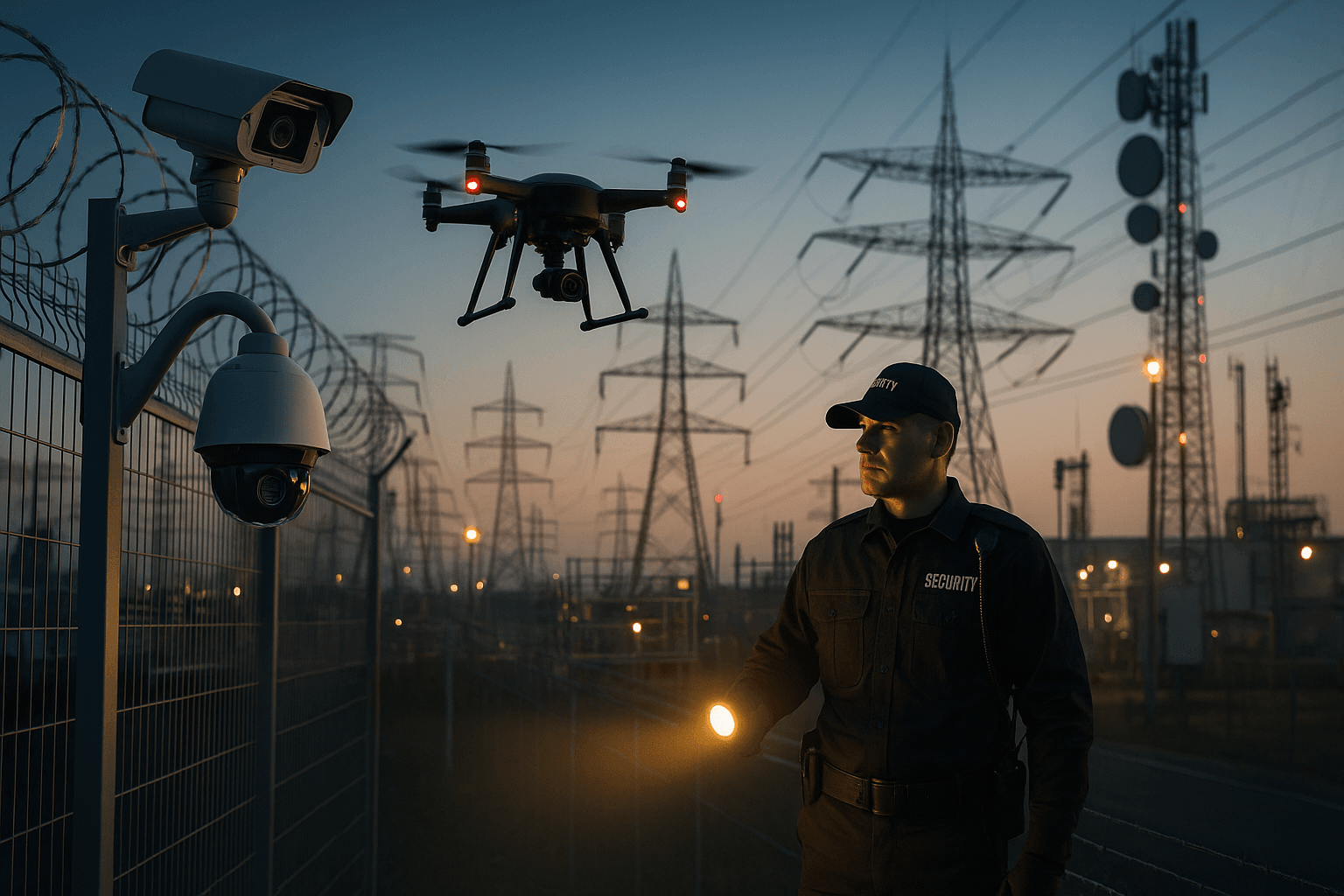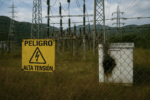As the boundaries between peace and conflict blur in the era of grey-zone and hybrid competition, protecting critical infrastructure is essential. Systems such as power grids, transportation networks, communication channels, water supplies, and energy pipelines form the backbone of modern society. They support economic stability, safeguard public safety, and underpin national security.
These networks are also deeply interdependent. A disruption in one sector often cascades into others, amplifying its impact. For example, a power grid failure can halt trains, disrupt communications, and cripple emergency services.
The consequences of sabotage or disruption extend far beyond financial costs. They can create societal instability, trigger environmental damage, and even result in the loss of life.
As threats grow more sophisticated—ranging from cyberattacks to physical sabotage—the need for stronger defenses is clear. Protecting these vital systems requires a mix of advanced technologies, robust policies, and international collaboration. Together, these measures build resilience and ensure that infrastructure continues to function even under stress.
Understanding the Threat Landscape
Critical infrastructure faces threats from diverse sources, each requiring tailored strategies for mitigation and response. These threats include state-sponsored actors, terrorist organizations, insider threats, hacktivists and cybercriminals, and natural or accidental risks.
State-Sponsored Actors
Nations often employ sabotage to destabilize adversaries, project power, or gain strategic advantages. Cyberattacks on critical infrastructure have become a hallmark of state-sponsored activities. For example, the U.S. has accused Chinese government-backed hackers of targeting American infrastructure to position themselves for potential disruptions. A 2020 investigation revealed that these groups had infiltrated systems controlling critical facilities, such as power grids and water treatment plants.
(RAND Commentary on Threats to U.S. Infrastructure)
Russia has also been implicated in infrastructure sabotage, most notably in Ukraine. The 2015 and 2016 cyberattacks on Ukraine’s power grid, attributed to Russian hacking groups, left hundreds of thousands without electricity and showcased the use of cyber tools to disrupt civilian life during geopolitical conflicts.
The increasing sophistication of state-sponsored cyberattacks emphasizes the need for proactive measures, such as international norms, to limit the targeting of civilian infrastructure and robust cyber defenses for critical systems.
Terrorist Organizations
Terrorist groups frequently target critical infrastructure to cause widespread disruption, incite fear, and draw attention to their agendas. Such attacks can cripple essential services, disrupt economic activity, and create long-lasting societal impacts. For example, in 2016, militants in Nigeria attacked energy pipelines, causing significant oil spills and interrupting the nation’s primary economic lifeline. Similarly, in 2019, coordinated bombings on transportation systems in Sri Lanka disrupted key logistical networks and paralyzed public services.
Advancements in technology have amplified these threats, enabling extremist groups to use tools like artificial intelligence to enhance their capabilities. AI can be exploited to design more effective explosive devices, identify vulnerabilities in complex systems, or automate cyberattacks targeting infrastructure such as power grids and water treatment facilities. Researchers warn that such advancements lower the barriers to entry for executing sophisticated attacks, increasing the risks to global infrastructure systems.
(Wired article on emerging threats)
To counter these evolving threats, governments are strengthening surveillance systems, fostering intelligence sharing between nations, and building public-private partnerships to improve the resilience of critical infrastructure. These measures aim to anticipate and mitigate potential attacks before they occur, ensuring the continued security of essential services
Insider Threats
Insider threats are among the most challenging to detect and prevent. Employees or contractors with legitimate access to sensitive systems can exploit that access for malicious purposes. Motivations range from ideological or political beliefs to personal grievances or financial gain.
A notable example occurred in 2013 when a disgruntled employee sabotaged a power substation in California. The attack caused extensive damage, leaving thousands without power and exposing vulnerabilities in the physical security of critical infrastructure. Insider threats can also occur in digital environments, where trusted individuals may compromise sensitive systems through intentional actions or negligence.
Organizations are addressing insider threats through enhanced screening processes, continuous employee activity monitoring, and fostering a workplace culture that discourages grievances from escalating to sabotage. However, balancing these measures with employee privacy remains a key challenge.
Hacktivists and Cybercriminals
The increasing digitization of critical infrastructure has opened new avenues for hacktivists and cybercriminals to exploit vulnerabilities. Hacktivists, driven by ideological or political motives, often target infrastructure to make statements or protest perceived injustices. Cybercriminals, on the other hand, are typically motivated by financial gain.
The 2021 Colonial Pipeline ransomware attack is a prime example of cybercriminal activity targeting critical infrastructure. The attack, carried out by the DarkSide hacking group, forced the shutdown of a 5,500-mile pipeline that supplies nearly 45% of the fuel to the U.S. East Coast. The resulting fuel shortages caused widespread panic buying, economic disruption, and increased scrutiny of cybersecurity practices in the energy sector.
(Reuters coverage of Colonial Pipeline attack)
The rise of ransomware-as-a-service (RaaS) platforms has made sophisticated attacks more accessible to less technically skilled actors, further complicating efforts to secure critical systems. Enhanced cybersecurity measures, including zero-trust architectures and threat intelligence sharing, are vital for mitigating these risks.
Natural and Accidental Risks
Not all threats to critical infrastructure are intentional. Natural disasters and human error can create disruptions just as damaging as sabotage. These events highlight the importance of resilience and robust mitigation strategies.
The 2003 Northeast blackout in the U.S. and Canada is a clear example. A single software bug triggered cascading failures across the grid. In just hours, more than 50 million people lost power, exposing the fragility of aging and interconnected systems.
Natural disasters regularly cause similar crises. Hurricanes, earthquakes, and wildfires damage power lines, water supplies, and communication networks. Hurricane Maria in 2017 devastated Puerto Rico’s power grid, leaving communities without electricity for months. The outage crippled healthcare, transportation, and commerce, amplifying the human toll of the disaster.
Governments and organizations are now investing heavily in resilient infrastructure. Solutions include modular power grids, climate-resistant materials, and decentralized energy systems. Just as important are regular maintenance and system updates. These measures reduce the risk of human error and technical failure while strengthening defenses against natural hazards.
Specific Regional Examples
While threats to critical infrastructure are universal, each region faces unique challenges influenced by geopolitical dynamics, economic conditions, and technological capabilities. These examples highlight the diversity of threats and the importance of region-specific protection strategies.
Africa
Pipeline Sabotage in Nigeria
Nigeria, Africa’s largest oil producer, faces a persistent struggle with pipeline sabotage. Militant groups, driven by economic grievances and environmental degradation, frequently target oil infrastructure across the Niger Delta. In 2022 alone, more than 1,100 cases of pipeline vandalism were reported. These attacks caused major financial losses and disrupted energy supplies both within Nigeria and abroad.
The Nigerian National Petroleum Corporation (NNPC) estimates that sabotage costs the country billions of dollars in lost revenue every year. For an economy heavily dependent on oil exports, these losses further weaken growth and stability.
Pipeline sabotage also creates severe environmental and health crises. Oil spills contaminate rivers, groundwater, and farmland, leaving communities exposed to long-term damage. Public health problems often follow, compounding social unrest. Groups such as the Movement for the Emancipation of the Niger Delta (MEND) have used sabotage not only as a weapon but as a political statement. Their attacks draw attention to local grievances, fueling a cycle of violence and instability.
Addressing these threats requires more than just military protection of infrastructure. Long-term solutions depend on community engagement and economic reforms that address the root causes of militancy. Without tackling poverty, unemployment, and environmental neglect in the Niger Delta, sabotage will remain a recurring threat to both Nigeria’s security and the global oil market.
Cyberattacks on Power Grids in India
In 2020, a massive power outage plunged Mumbai—India’s financial hub—into darkness. The blackout disrupted hospitals, halted transportation systems, and affected millions of residents. Investigations later suggested that the incident was not accidental. Evidence pointed to a sophisticated cyberattack, with analysts linking the operation to state-sponsored groups connected to China.
The timing was significant. The attack occurred during a period of heightened tensions between India and China, raising fears that sabotage of critical infrastructure could become a tool in geopolitical conflict. The Mumbai incident highlighted how cyberwarfare can undermine national security, public safety, and economic stability without a single shot being fired.
In response, India strengthened its cybersecurity defenses. The government established the Computer Emergency Response Team (CERT-IN) at the national level to monitor threats, detect intrusions, and coordinate incident responses. Despite these advances, challenges remain. Much of India’s power grid infrastructure is aging, and many sectors still lack comprehensive cybersecurity protocols, leaving potential entry points for future attacks.
The Mumbai blackout serves as a stark warning: cyberattacks on power grids are no longer hypothetical. They represent a growing vulnerability in Asia and a frontline in the evolving landscape of irregular and hybrid warfare.
Europe
Undersea Cable and Pipeline Sabotage in the Baltic Sea
The Baltic Sea region has become a hotspot for critical infrastructure sabotage, often tied to geopolitical tensions involving Russia. In 2024, the suspected sabotage of the Estlink 2 submarine power cable, which connects Estonia and Finland, reduced cross-border electricity capacity and highlighted vulnerabilities in undersea infrastructure. Investigations pointed to the deliberate involvement of vessels linked to Russian interests, reflecting broader hybrid warfare tactics used by the Kremlin.
(Wikipedia – Estlink 2 Incident)
The region has also experienced attacks on gas pipelines, such as the Nord Stream pipeline explosions in 2022, which disrupted energy supplies to Europe. These incidents underline the importance of securing critical infrastructure in the context of energy dependence and geopolitical rivalry. European nations are investing in underwater surveillance systems, hardening cable infrastructure, and strengthening NATO’s collective response capabilities to mitigate such threats.
Latin America
Cyber Sabotage and Power Grid Blackouts in Venezuela
Venezuela has faced repeated attacks on its power grid, most notably a nationwide blackout in 2019 that left millions without electricity for days. The Venezuelan government attributed the incident to cyber sabotage, claiming that external actors targeted the country’s Guri Dam, which supplies most of its electricity. While independent investigations could not verify these claims, the incident exposed significant vulnerabilities in Venezuela’s aging and poorly maintained energy infrastructure.
The blackout severely disrupted water supplies, transportation, healthcare services, and food distribution. It also highlighted the intersection of political instability and infrastructure sabotage, as deteriorating governance and economic crises have made Venezuela more vulnerable to both internal and external threats.
Key Takeaways
These regional examples underscore the importance of tailoring protection strategies to specific threats and circumstances. For instance:
- In Africa, addressing the socio-economic drivers of sabotage is as important as securing physical infrastructure.
- In Asia, improving cybersecurity measures is critical to defending against state-sponsored attacks.
- In Europe, collaboration among nations and investments in advanced surveillance technologies are necessary to safeguard undersea and energy infrastructure.
- In Latin America, modernizing outdated infrastructure and addressing governance challenges are key to reducing vulnerabilities.
By understanding and addressing the unique challenges in each region, nations can enhance the resilience of their critical infrastructure and mitigate the risks posed by sabotage.
Emerging Threats
New technologies and tactics are reshaping the threat landscape:
- AI-Driven Cyberattacks: Artificial intelligence allows attackers to automate and scale sabotage efforts. For instance, malware like IOCONTROL demonstrates the increasing sophistication of threats. (TechRadar article on malware threats)
- Drone-Based Sabotage: In 2019, drones were used in an attack on Saudi Aramco oil facilities, halting half of the country’s oil production and impacting global markets.
- Deepfake and Disinformation Campaigns: Deepfake technology can create fake messages or videos, delaying responses to sabotage incidents and undermining public trust.
Legal and Policy Frameworks
Governments and organizations worldwide are taking significant steps to develop legal and policy frameworks for protecting critical infrastructure. These frameworks aim to address vulnerabilities, standardize response mechanisms, and foster collaboration across sectors and nations. Here are some key initiatives:
CISA (U.S. Cybersecurity & Infrastructure Security Agency)
The U.S. Cybersecurity & Infrastructure Security Agency (CISA) plays a central role in safeguarding the nation’s critical infrastructure. It offers guidelines for identifying and mitigating vulnerabilities, conducts red team assessments, and provides resources for public and private sectors to strengthen their cybersecurity posture. CISA focuses on collaboration, creating initiatives like the Cybersecurity Advisory Committee to bring together experts from industry and academia.
In response to increasing ransomware threats, CISA launched the StopRansomware.gov platform, a centralized hub providing tools and information to help organizations prevent and respond to ransomware attacks. Additionally, CISA’s National Risk Management Center (NRMC) develops strategies for managing risks to critical infrastructure and coordinating responses to significant disruptions.
(CISA Red Team Insights)
European Union’s NIS Directive
The European Union’s Network and Information Security (NIS) Directive was the first piece of EU-wide cybersecurity legislation. It aims to ensure a high common level of cybersecurity across member states. The directive applies to operators of essential services (OES) such as energy, transport, and healthcare, as well as digital service providers (DSPs) like online marketplaces and cloud computing services.
Key components of the directive include:
- Risk Management Obligations: Organizations must adopt appropriate security measures and report significant incidents to national authorities.
- National Cybersecurity Authorities: Each member state is required to establish authorities to oversee the directive’s implementation and coordinate at the EU level.
- Cross-Border Cooperation: The directive facilitates the sharing of information and collaboration between member states to address cyber threats effectively.
The directive was recently updated and replaced by NIS2 in 2023, which expands its scope and introduces stricter requirements for incident reporting and risk assessment.
(European Commission – NIS Directive)
International Efforts
Global collaboration is essential for addressing the transnational nature of cyber threats. Organizations like the International Telecommunication Union (ITU) and other United Nations agencies promote global initiatives to enhance cybersecurity and protect critical infrastructure:
- Global Cybersecurity Agenda (GCA): Established by the ITU, the GCA is a strategic framework for coordinating international efforts in combating cybercrime and securing critical systems.
- Capacity Building: The ITU assists developing nations in building their cybersecurity capabilities through training programs, resource allocation, and knowledge-sharing platforms.
- Cybersecurity Readiness Index: The ITU’s Global Cybersecurity Index ranks countries based on their commitment to improving cybersecurity and encouraging international benchmarking and best practices.
Other notable initiatives include the Budapest Convention on Cybercrime, which facilitates international cooperation in addressing cybercrime while promoting legal harmonization. These efforts help establish norms for state behavior in cyberspace, such as refraining from targeting civilian infrastructure during conflicts.
(ITU Cybersecurity Resources)
Key Takeaways
Legal and policy frameworks are vital to ensuring the security and resilience of critical infrastructure. By promoting collaboration, standardization, and information sharing, these initiatives address the evolving nature of threats and help safeguard systems that underpin modern society. Strengthening these frameworks through regular updates and international cooperation is crucial in staying ahead of adversaries and minimizing the risks of sabotage or disruption.
Economic Impacts of the Colonial Pipeline Attack
Immediate Financial Costs
The direct financial impact of the 2021 Colonial Pipeline ransomware attack was substantial. Colonial Pipeline paid the DarkSide hacking group a ransom of $4.4 million in Bitcoin to regain access to its systems. While federal authorities later recovered some of the ransom, the company faced additional costs related to system recovery, enhanced cybersecurity measures, and legal fees.
Fuel Supply Disruption
The attack forced Colonial Pipeline to temporarily halt operations of its 5,500-mile pipeline, which supplies nearly 45% of the East Coast’s fuel, including gasoline, diesel, and jet fuel. This disruption caused widespread panic buying, leading to significant fuel shortages across several states. In North Carolina, Georgia, and Virginia, over 70% of gas stations reported being out of fuel during the peak of the crisis.
Increased Fuel Prices
The shutdown led to a sharp increase in fuel prices. The national average price of gasoline rose to $3.04 per gallon, the highest level since 2014. The price surge strained consumers and businesses alike, with transportation and logistics sectors—especially trucking and aviation—bearing the brunt of higher fuel costs and operational delays.
Ripple Effects on Supply Chains
Industries reliant on fuel experienced cascading effects. The trucking sector faced increased delivery costs, while aviation fuel shortages led to delays and higher ticket prices. These disruptions compounded existing supply chain challenges exacerbated by the COVID-19 pandemic, amplifying the economic toll.
Reputational Damage
The attack also inflicted long-term reputational damage on Colonial Pipeline. The incident exposed vulnerabilities in critical infrastructure, leading to public concern and heightened scrutiny from regulators and lawmakers. The event served as a wake-up call, pushing the energy sector to adopt stricter cybersecurity protocols and adhere to new directives issued by the Transportation Security Administration (TSA).
Broader Economic Impact
The total economic impact of the Colonial Pipeline attack, including ransom payments, fuel shortages, supply chain disruptions, and regulatory costs, was estimated to run into hundreds of millions of dollars. This case underscores the far-reaching consequences of infrastructure sabotage and highlights the importance of proactive security measures to mitigate such risks.
Emerging Technologies in Depth
- Quantum Encryption: Quantum cryptography is advancing toward making intercepted data virtually indecipherable, promising revolutionary improvements in infrastructure communication security.
- AI-Driven Predictive Analytics: AI can analyze patterns to predict potential sabotage events, allowing preemptive actions.
- Blockchain for Security: Blockchain’s tamper-proof records can help protect supply chains and resource allocation in critical infrastructure.
Conclusion
Protecting critical infrastructure is not merely a matter of national security—it is essential for maintaining societal stability, economic growth, and public well-being. As the threat landscape evolves with the advent of advanced technologies and geopolitical tensions, safeguarding these vital systems demands a proactive, multifaceted approach. Collaboration among governments, private organizations, and local communities is paramount to ensuring resilience against both traditional and emerging threats. By leveraging innovations like quantum encryption, predictive analytics, and blockchain, and by adhering to robust legal and policy frameworks, societies can better anticipate, mitigate, and recover from sabotage attempts. The stakes are high, but through vigilance, investment, and cooperation, we can secure the infrastructure that underpins modern life and ensure its continuity for generations to come
Sources
- RAND Commentary
- Wired – AI Threats
- Reuters – Colonial Pipeline
- Wikipedia – Estlink 2 Incident
- TechRadar – Malware on Critical Infrastructure
- CISA Red Team Insights
DISCLAIMER: Links included might be affiliate links. If you purchase a product or service with the links that I provide I may receive a small commission. There is no additional charge to you.





Leave a Reply